10 UNESCO World Heritage Sites to Visit in the Balkans
The Balkans, a region steeped in history, culture, and natural beauty, boasts a wealth of UNESCO World Heritage Sites. In this article, we explore...
Nikolina Konjevod 15 July 2024
Have you ever been called a tourist? Have you ever considered yourself one? Maybe for the time on a summer trip, or on your way to explore an unknown land that you dreamed about for years… I invite you to read and find out about few incredible figures that inspired me to hit the road in Northern Europe and revisit some fascinating 18th and 19th-century journeys.
Tourism became popular in the middle of the 17th century when young men from the most privileged classes of the Western societies began to journey through Southern Europe. These trips, romantically called the Grand Tours, were often sponsored by patrons who felt the need to push further the education of their pupils, which was mainly based on the studies of Greek and Latin and the exploration of the rich artistic and cultural heritage that deeply and undoubtedly shaped the Occident for the past centuries. What could be a more efficient way to do so, if not through the experiences of travel?
Those explorers mostly from Western countries such as England, Germany, or France, would leave their homes for months, even years, and guided by a chaperon on the quest of the past would cross the Alps to reach Italy and Greece. Later on, the courageous ones would set off for trips to the Middle East and Persia. Before the industrial revolution such journeys were extremely complicated, yet after the spread of railways, the unexplored lands started to be more accessible.
Many famous men chose this path of learning, but just to name a few: J. W. Goethe, Alexandre Dumas, Lord Byron and many Romantic painters that you might know by their breathtaking landscape paintings, such as J. M. W. Turner, Pompeo Batoni, Canaletto, Giovanni Piranesi, Thomas Moran, John Milton, and one of my favorites, Peder Balke.
I want to look at the Grand Tours in detail and examine the path of the pure Romanticism that artists and scholars had undertaken in search of the soul, and of the spiritual initiation. I decided to set off on a similar journey but instead of going south, my heart was much more oriented towards the north. I wanted to see and try to understand what John Graham, Knud Baade, Peder Balke, Ivan Aivazovsky, Turner, and many others had felt about 120 years ago.
So it was decided! A map in my pocket and a backpack on my back, I went north! From Ireland to the Nord Cape in Norway, and then crossing to Scotland. I was on my way for 2 months to learn as much as I could about myself and the artworks that followed me for so many years.
The north has always fascinated many. Multiple societies and civilizations have given a spiritual and divine dimension to these hostile, mysterious, and attractive lands.
In most Romantic novels and documentaries of explorations that I have been studying, one thing always reappears: by traveling north, you put your life in the hands of lands that will have the power to judge you, to give you answers, and to make you spiritually stronger.
And this idea haunted me… Based on a decision I made rather quickly, I went up to Nordkapp, Norway, 71 ° North for my first trip. With a list of paintings, a diary, a camera and The letters to a young poet by Rainer Maria Rilke, I spent 2 months trying to figure out the difference between the myths and my reality. And to share my story with you, I have decided to show you the paintings and photographs as well as extracts from my journal. And so the journey begins…
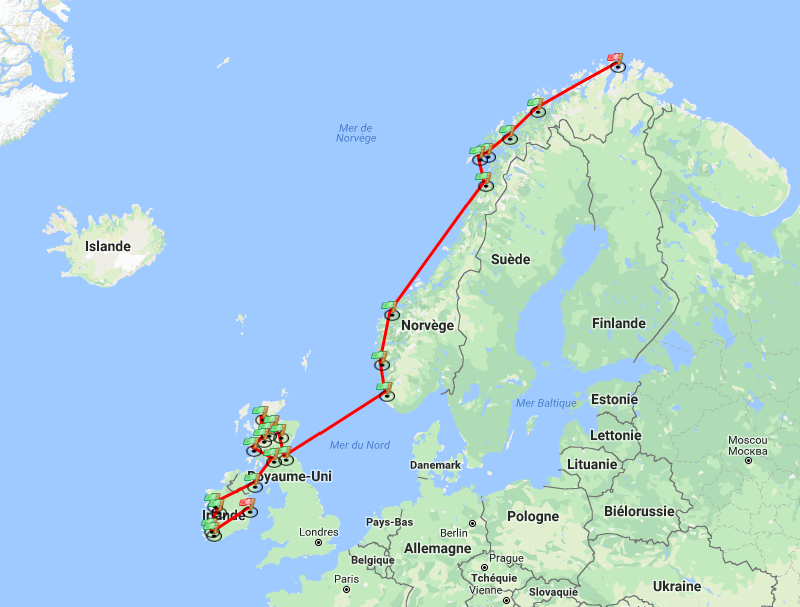
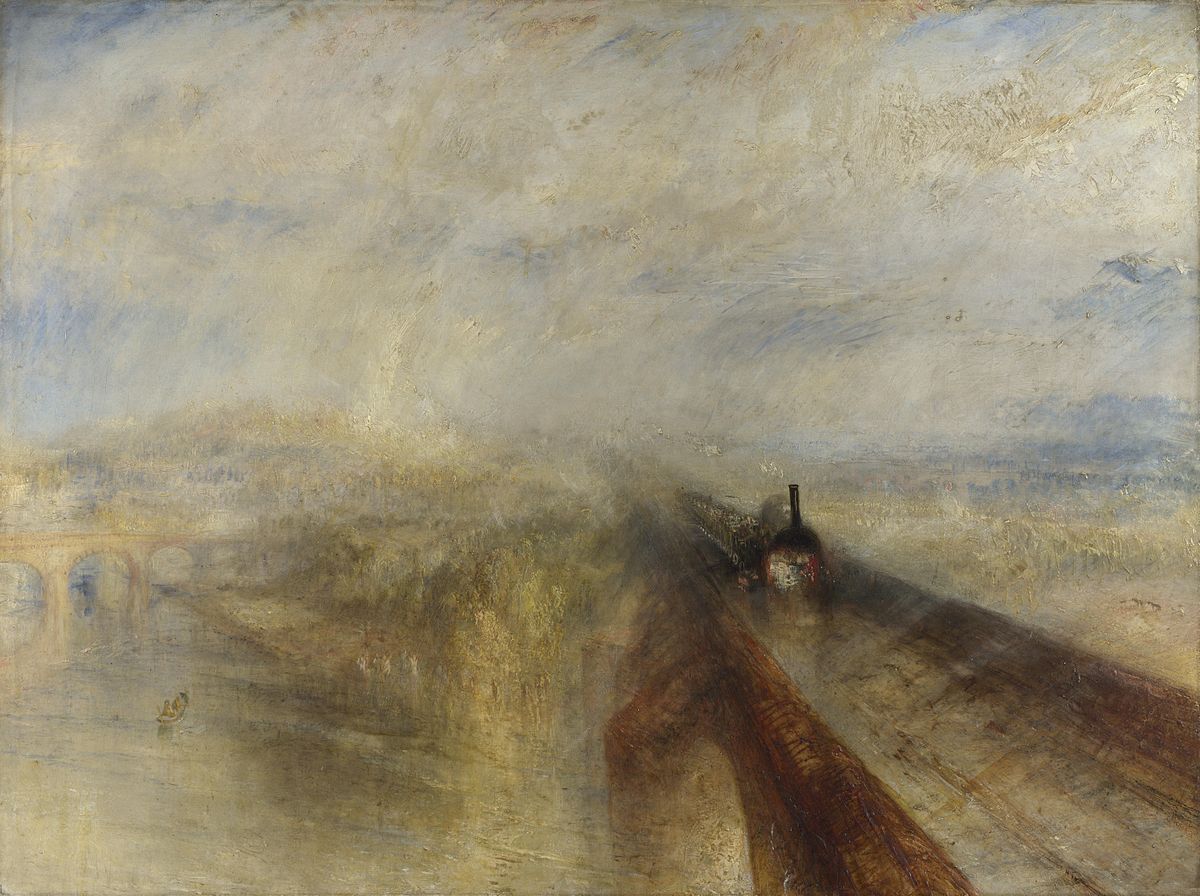
This first painting is by the great British artist William Turner (1775-1851). This scene is believed to represent the Maidenhead railway bridge, across the Thames between Taplow and Maidenhead. The bridge was built between 1837 and 1839, from a design by Isambard Kingdom Brunel. This painting’s impression of speed and Romanticism inspired me to buy a one-way ticket on the Jacobite train. A train made famous in the saga of Harry Potter, under the name of the Hogwarts Express platform 9 3/4. If today you feel like taking this trip, it goes from Fort William to Mallaig in Northern Scotland.
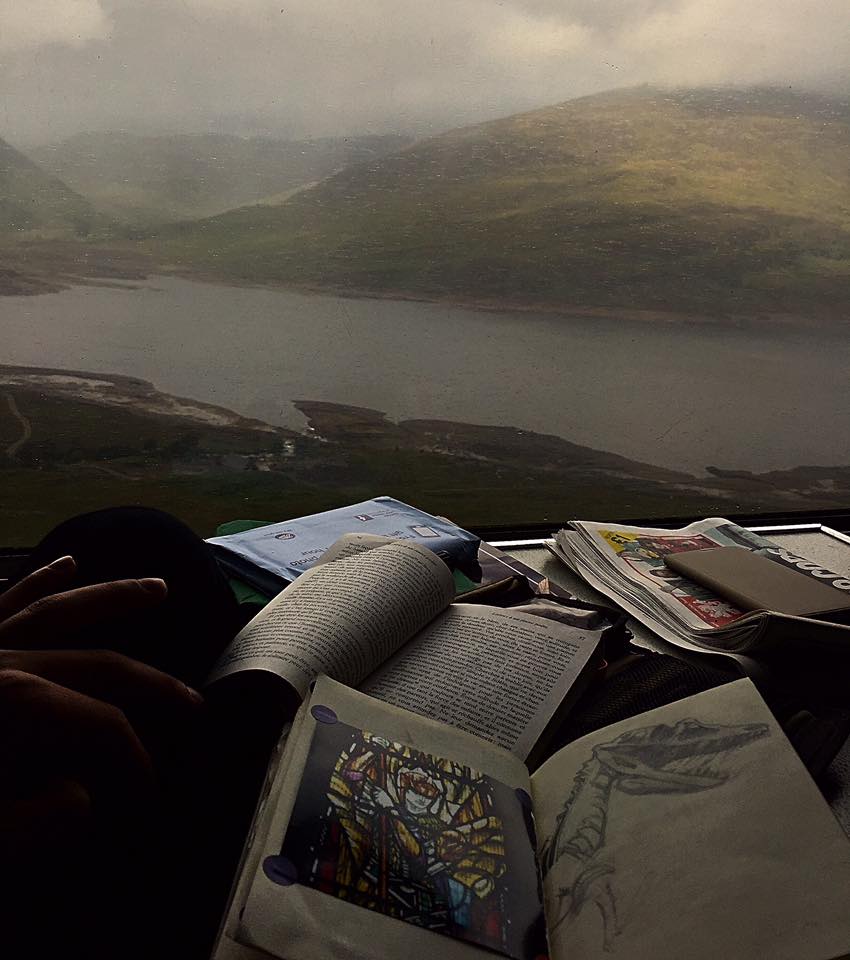
“And this is where it all really begins for me, rocked by the sound of steel coming to life under my feet, the wheels of the Jacobite Train. And it is such a joy to let myself be hypnotized by the melody, what a beautiful symphony. Thick black clouds perfume of delight, they appear to me like a curtain that stretches and rises delicately on the land of dreams.“
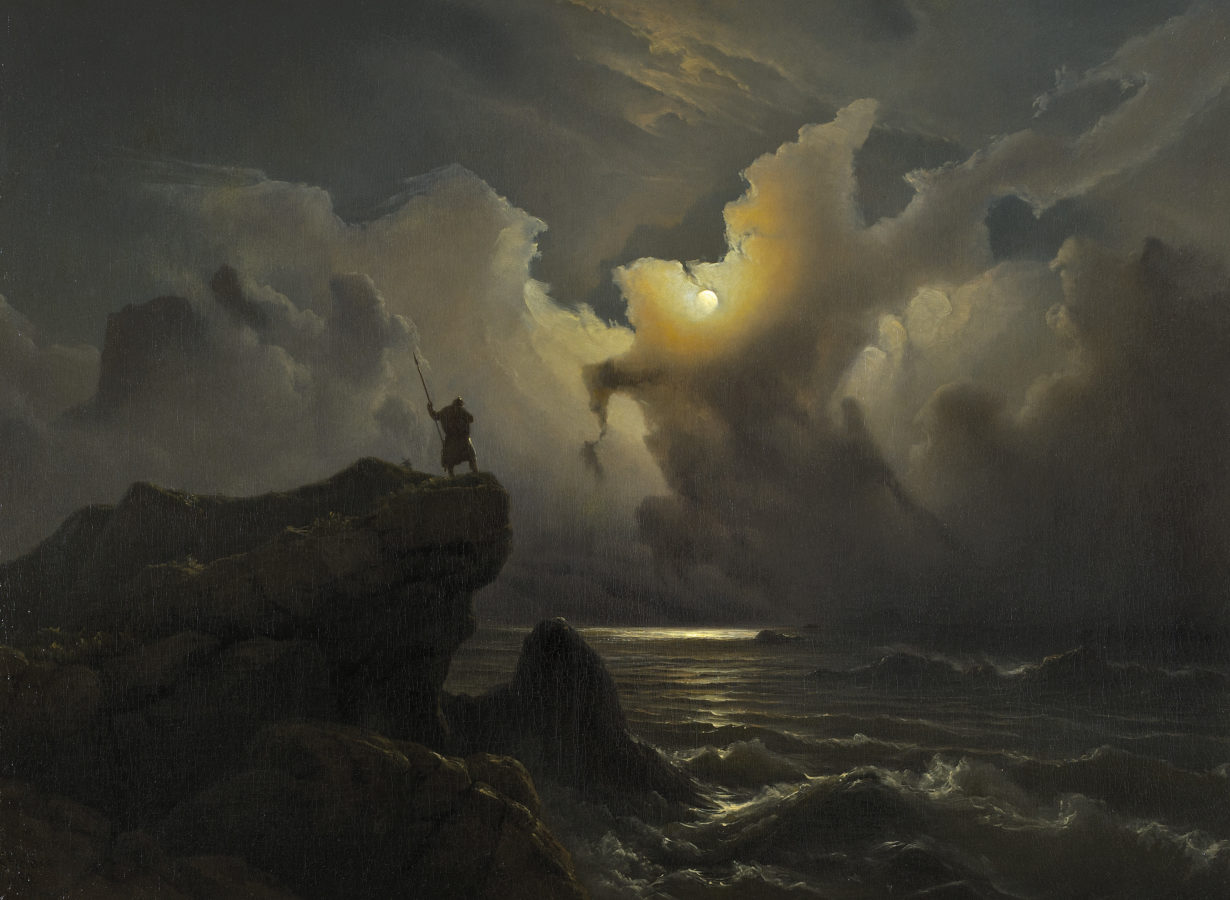
Knud Andreassen Baade (1808-1879) was a Norwegian painter, particularly known for his moonlight paintings which are recognizable by the powerful and dramatic contrasts between light and shadow.
In 1836, Johan Christian Dahl, encouraged Baade to go to Dresden, where he studied for three years, and where he met Caspar David Friedrich. In 1846, he moved to Munich, where he produced, what I consider, masterpieces of his country.
His work and this painting in particular, made me want to experience the depth that a solitary hike and contemplation can teach you about yourself on a level that is I believed close to religion, something that you might know under the name of pantheism.
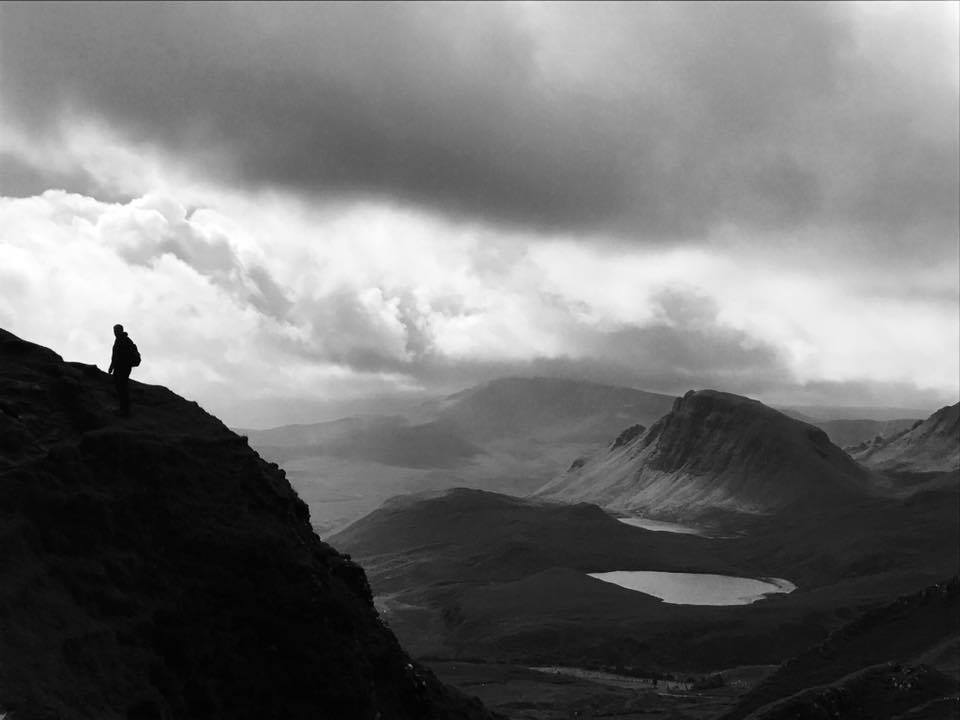
“The Solitary soul that Rainer Maria Rilke describes in The Letters to a Young Poet start to resonate in me. A feeling of loneliness, in which the elderly find a comfort and which frightens the youth. A feeling that makes me embrace the Unknown and dispels the demons of anxiety. I try to keep my emotions for later when I’ll be sitting at the window of a night train, which will guide me north; half-asleep going through the ecstasy of the moon caressing the living landscapes before me blurred by tears of gratefulness and hope for a future for me here in Scotland.“
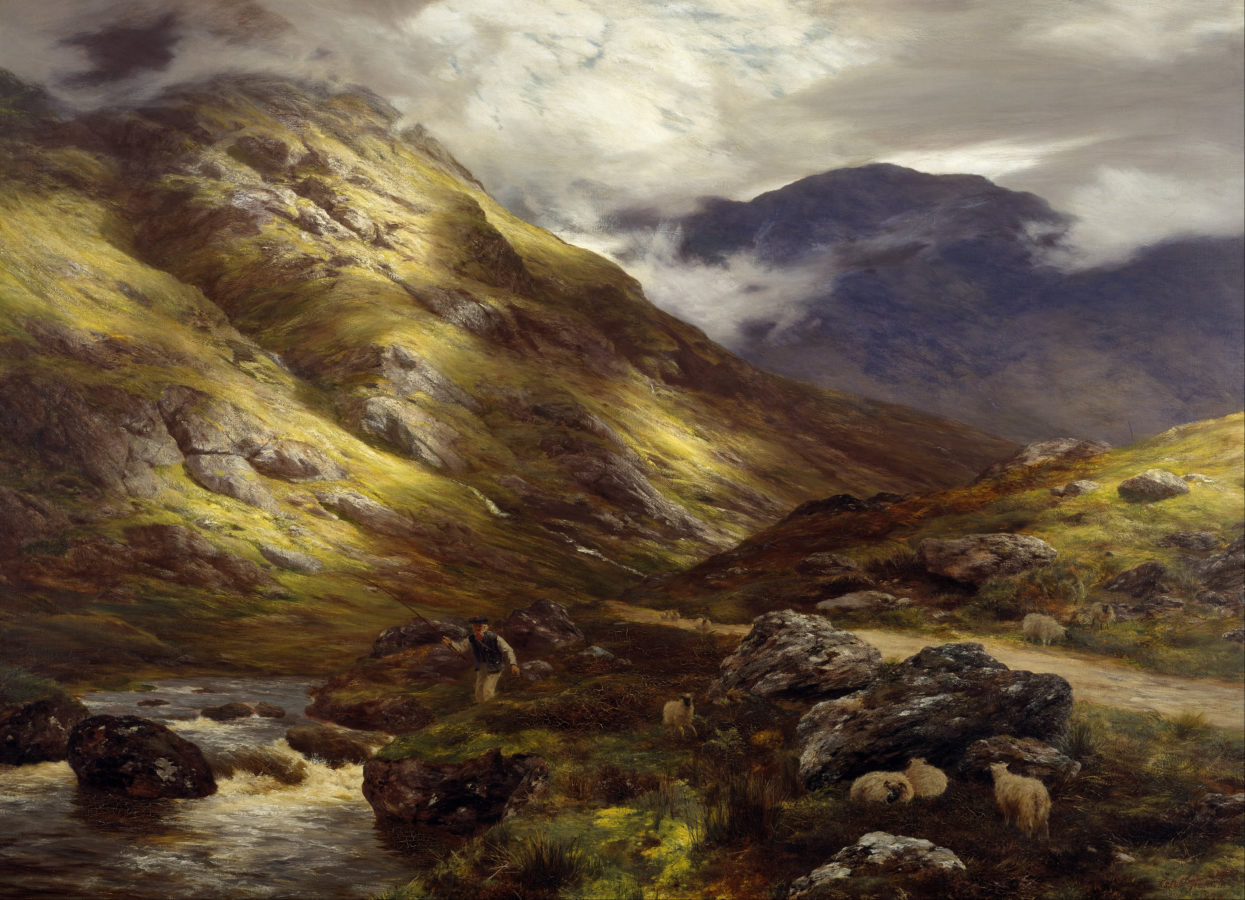
Peter Graham (1836-1921) had the eyes and the hand of a man who could see beyond rocks and fog, and had the ability to transcribe his feelings onto canvas. The variations of lights and colors in his landscape paintings particularly appealed to a city-based audience. From heaven to earth, the way he depicted clouds and nature creates a harmony that, no matter what, pushed me to explore it on my own and let my mind be driven for days of walking…

“It is difficult for me to find another word than mysti to describe what I see right now. This harmony has the limit of pantheism, which is not. It was really naive of me to believe that I could understand this nature or find words to name it. Now I realize that it all happens within you, in a way that ignores words. The quest for more, always more, abandons me for an instant and gives way to a deep sense of gratitude.”
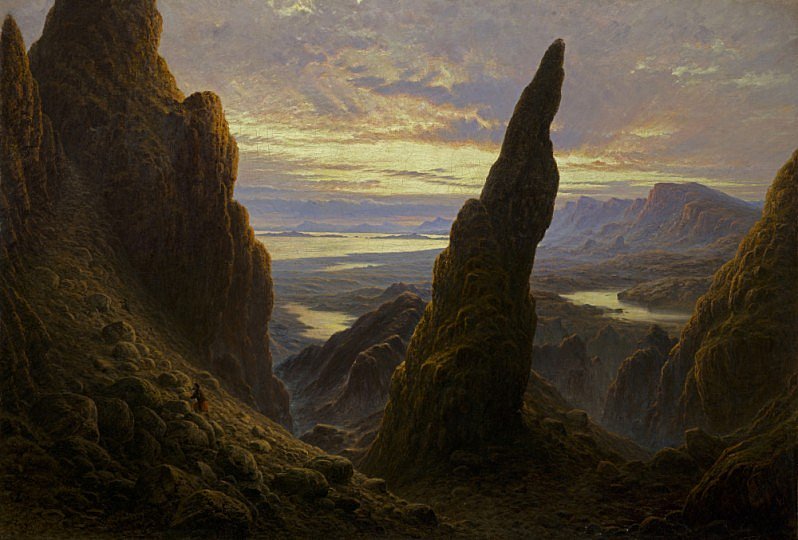
Waller Hugh Paton (1828-1895), younger brother of the artist Sir Joseph Noel Paton, worked on meticulously depicting the beauty of Scottish Highlands. He was both skilled in oil and watercolor paintings. He was elected to the Royal Scottish Academy in 1865. When I saw in Edinburgh this painting of the Cuiraing, it felt just right for me to put it on the list of the places I had to see by myself even if it was probably embellished in this artwork.
The only place that was similar, of which I heard, was the Old Man of Storr, located in the Isle of Sky in the Highlands, Scotland.
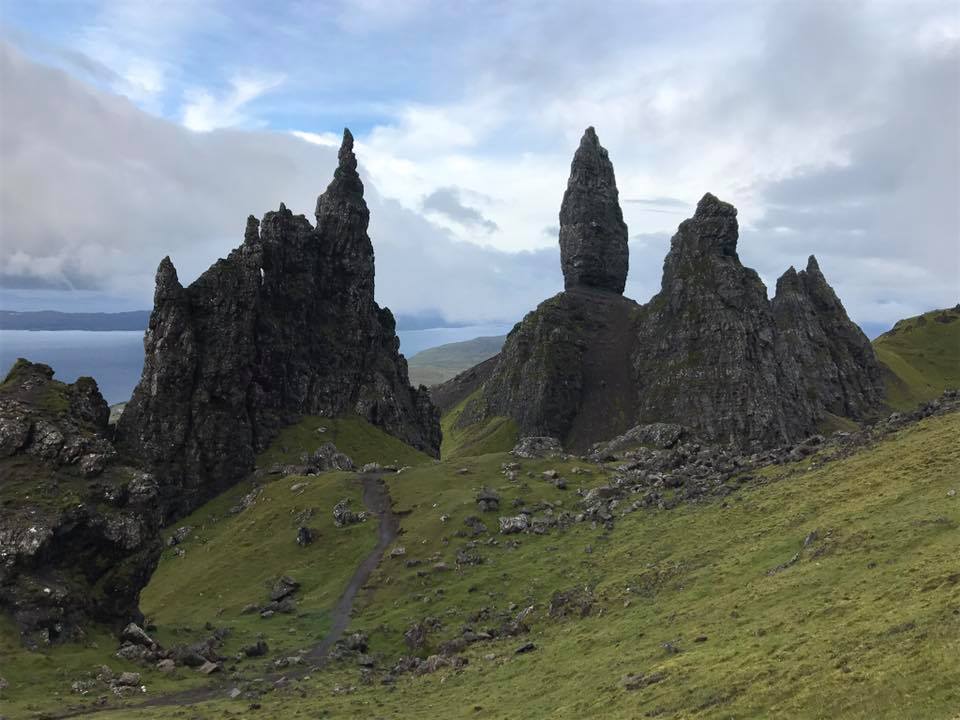
“A tower of menace, a finger pointing to the peaks of your loss, if out of boldness you dare to grab my rocks and climb. I’m getting an almost nauseous feeling when I realize that I am surrounded by Turner, John Martin, and Peter Graham. Trapped in a world of Benicio del Toro, Hayao Miyazaki, and so much more.
My ears are rocked by the soundtracks of Wojciech Kilar, and later some traditional Persian music. My heart is racing, my feet are walking so badly, I stop for a moment, breathe, and start this little adventure, so ephemeral and precious!”
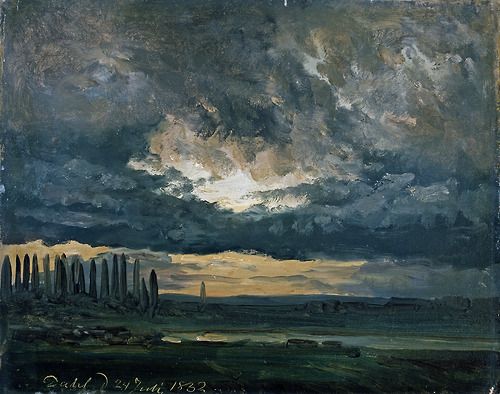
Johan Christian Dahl (1788-1857), was an artist considered the first great Romantic painter in Norway, the founder of the “golden age” of Norwegian painting.
Dahl spent much of his life outside of Norway, transcribing his love for his country in his work. Later in his life, he became one of the founders of the Norwegian National Gallery and of several other major art institutions there. In Dahl’s work, I could see something that I dreamed of as a child and hoped to see one day while crossing these lands on a boat. A dark sky that only allows a column of light to strike the sea. A sea that becomes gold and that would make me feel like I was doing my Grand Tour depicted in The Vampyre by Polidori, published in 1819.
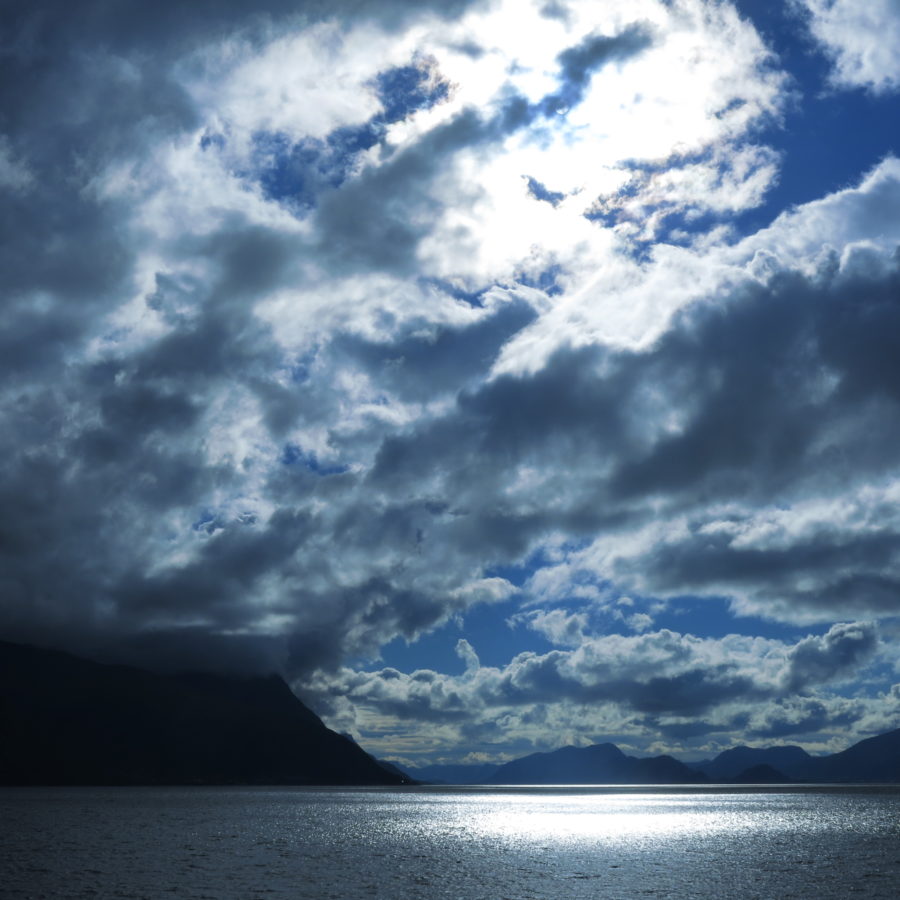
“How to write about the color of a feeling, or in my case the feeling of the color before my eyes. It is blue, it is nuanced, cold and cross my bones, catches the beating of my heart than having reached its goal gently. I can feel in my chest this slowdown that happens as the earth disappears from my sight. A deep breath to the rhythm of the clouds that move and grow as one with the sky.”
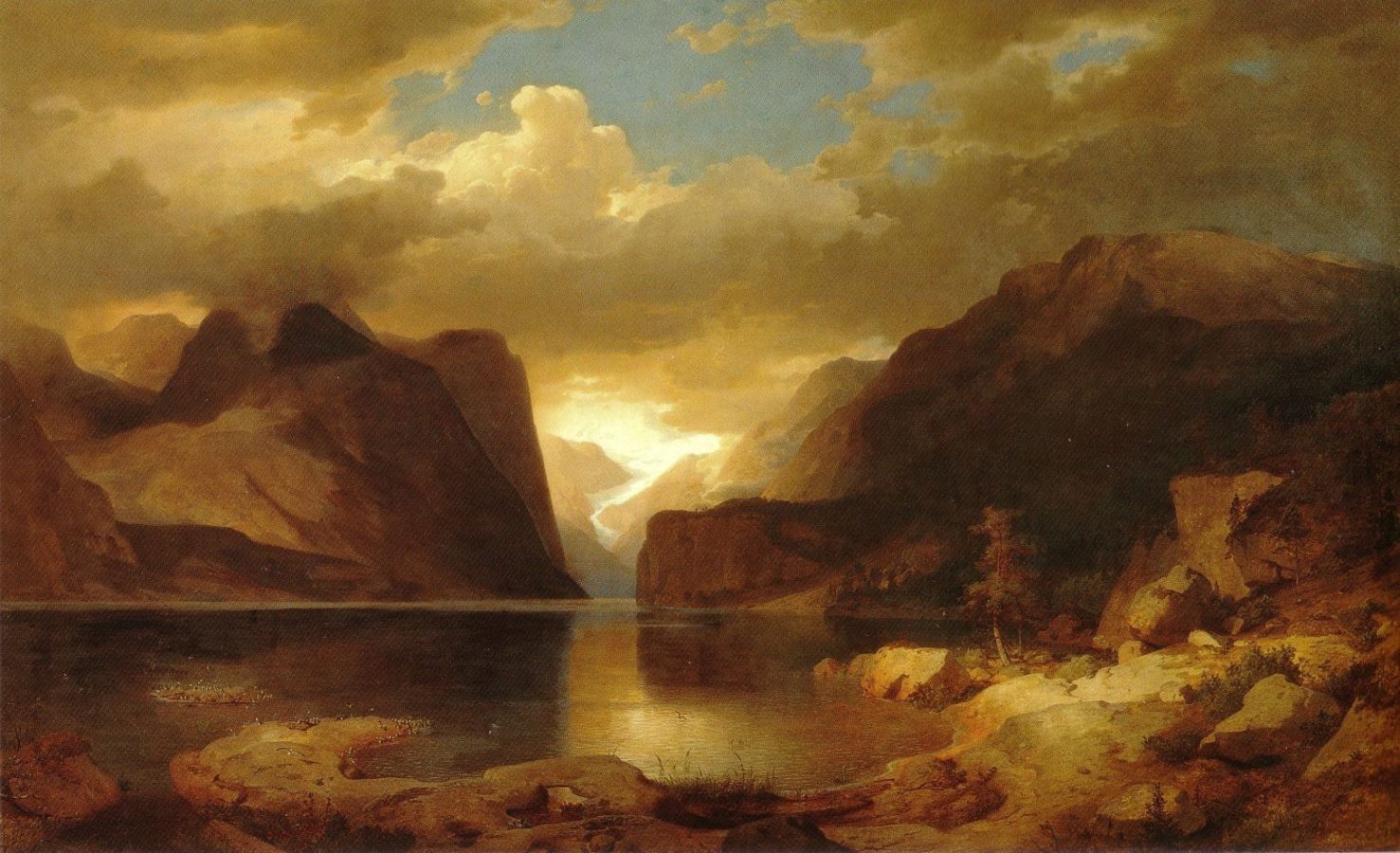
Andreas Achenbach (1815-1910) started his art education in Düsseldorf at the age of 12 years old, under Friedrich Wilhelm Schadow at the Düsseldorf Academy of Painting. He travelled to Italy, Holland and the Nordic countries. Following the idealism of the German Romantic school that we find in his early production, Achenbach moved to Munich in 1835, where he was strongly influenced by Louis Gurlitt that brought his work to a whole new level. He was, and still is, a pioneer of the German Realist school.
The Hardanger Fjord depicted here has been an important region for European tourism since the 19th century. The area offers spectacular views and culture. 179 km long and the 3rd longest fjord in the world, it is mostly known now for the so-called Trolltunga.

“And so here are your peaks, I try lately to get out of the binary type comparison of things. But in this case, it is particularly striking… To my right, your high herbs rising to the sky between green and yellow and brown tips flapping in the wind in a familiar melody that Mr. Joe Hisaishi would transcribe so well. And to my left, the emptiness reminder of my recent path through an unknown city. The morning in the distance met in the center by the immortal and calm sea sliced by a horizon of smoke. A 1000 meters separate me from the void but I have to bend over to feel you, the danger becomes a notion, an echo of the past that has no place in the contemplation of the present and the immortal.”
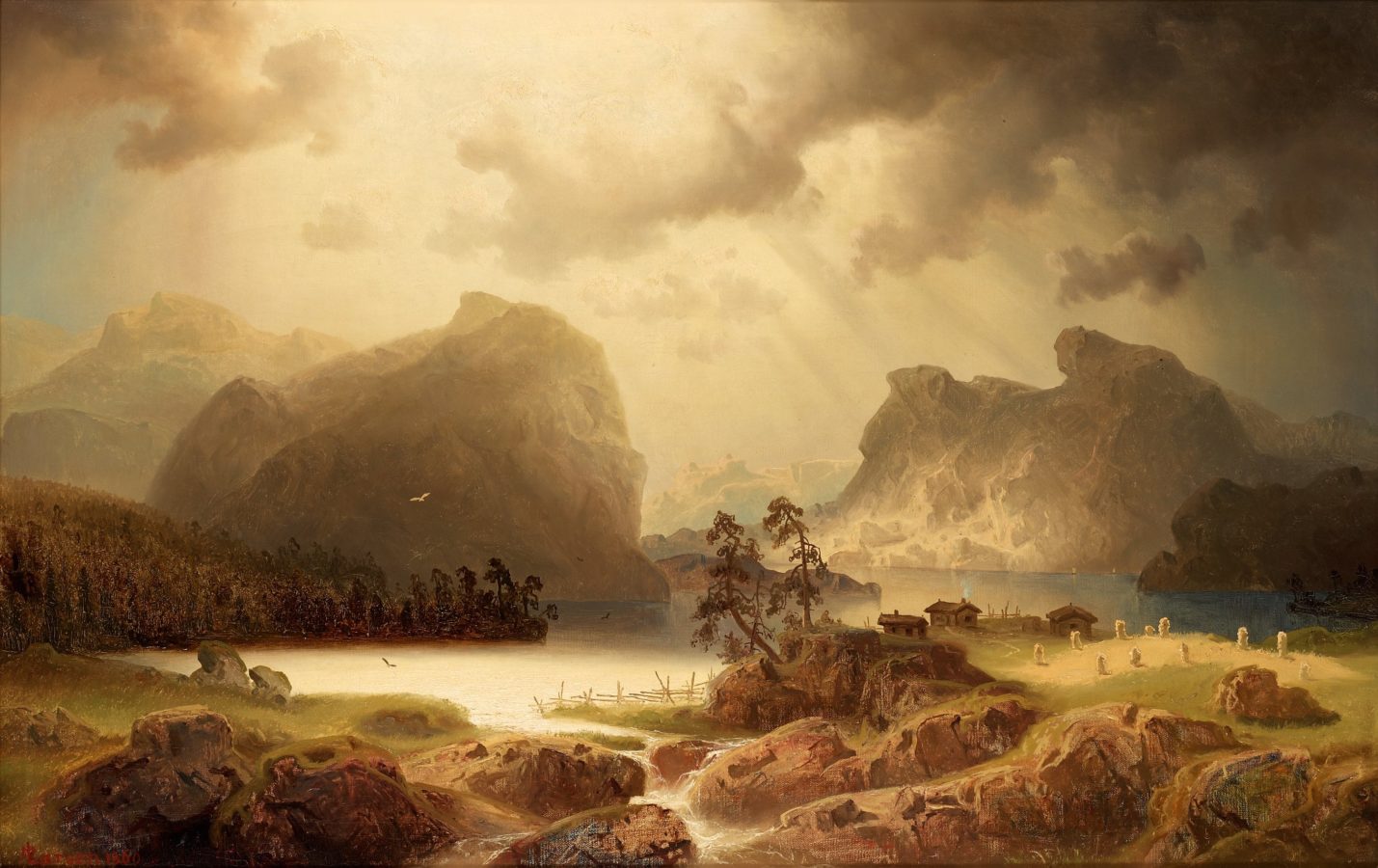
Marcus Larson (1825-1864) was a Swedish landscape painter from Åtvidaberg, Östergötland. After the death of his father, Larson moved to Stockholm to get a job and was hired by a saddle maker, who saw Larson’s talent for drawing. Later on, Larson received the permission to attend evening courses at the Royal Swedish Academy of Arts.
While at the Academy, Larson discovered his calling for painting and decided to start a career in art after finishing his studies between 1846 and 1848. In 1850, he received lessons in marine genre by Vilhelm Melbye and put his skills to practice when he traveled with the corvette Lagerbjelke on an expedition to the North Sea.

“Is there a language hidden in the mist? A dialect that is offered to us with a kind of infantile teasing, images are mothers of inspiration. It can be indulgent and only be the framework of the maturity of the beloved painters or become a mountain in a quarter of a second, defying any common sense of gravity.”
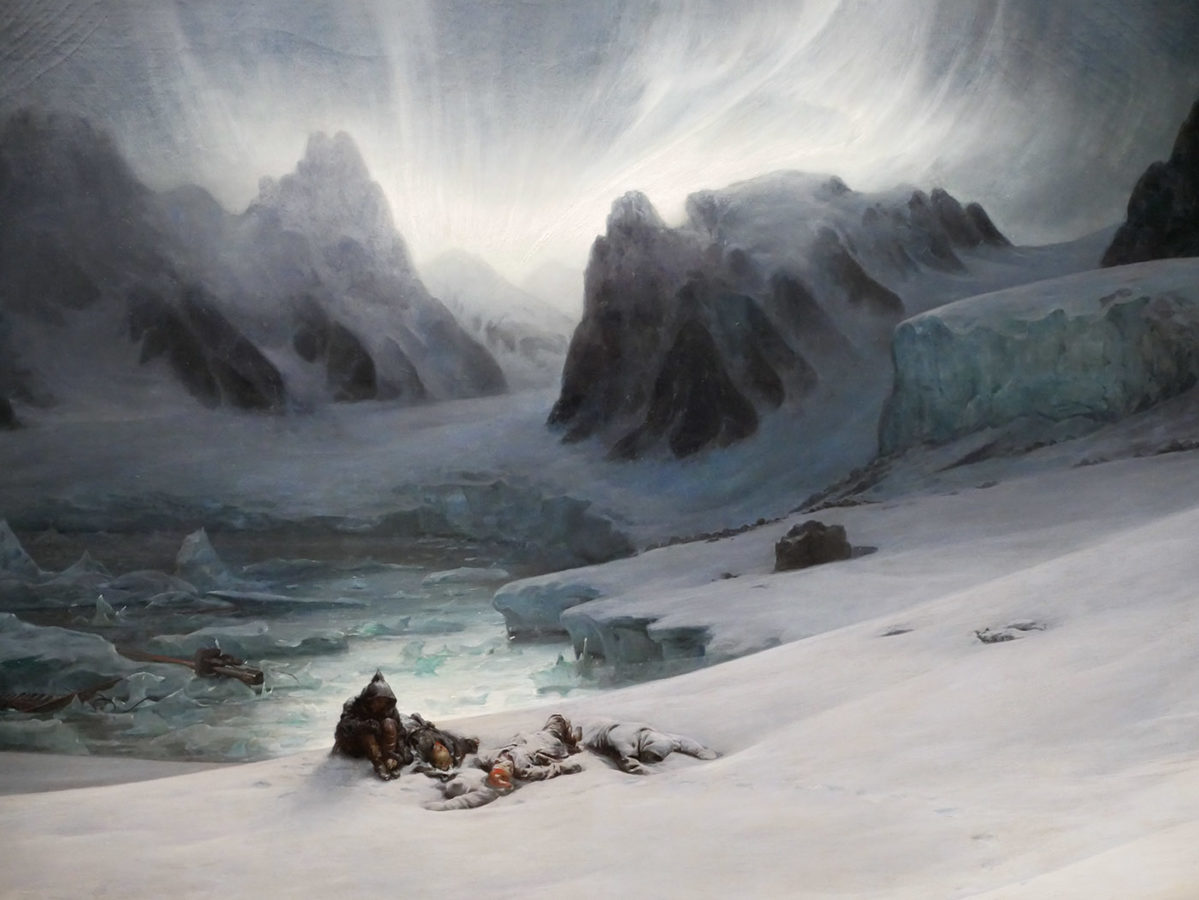
François Auguste Biard (1798-1882) was a French genre painter that traveled extensively around the world during his life. This painting was inspired by a scientific expedition that Biard and his wife were part of, on board of the Corvette, La Recherche, in the Arctic from 1838 to 1840. No life was lost, as the painting suggest you to believe. But you might have heard of a tragic adventure that happened to the crew of the HMS Terror during their mission to find a passage through the North-West in 1845.
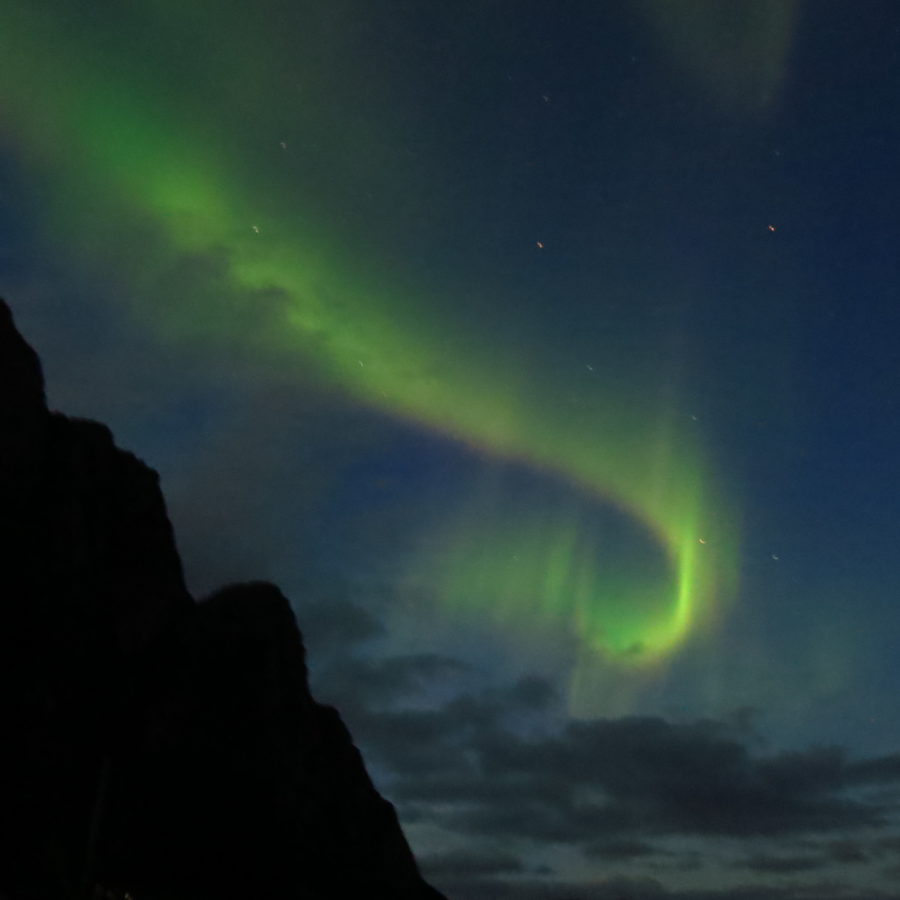
“Such a divine light, this sign that so often engages gratefulness within me, the need to thank a cosmic order that could only be responsible for such a surge of beauty. A light above my head that enhances the blue of infinity, lapis lazuli that slowly warms my heart, and caresses my soul.”

Peder Balke (1804-1887) was a Norwegian painter and an activist in the field of social justice. In 1830 Balke traveled to Telemark, Rjukan, Vestfjorddalen, through Røldal and Kinsarvik, to the city of Bergen, and then back through Vossevangen to Gudvangen, further over Filefjell to Valdres and then across the mountains to Hallingdal.
A view from the Nord cap by Balke was the painting that motivated this whole trip. I felt deeply connected to his work, and even today it is hard for me to explain why exactly, but I had made a promise to myself, that one day, I would see this place with my own eyes.
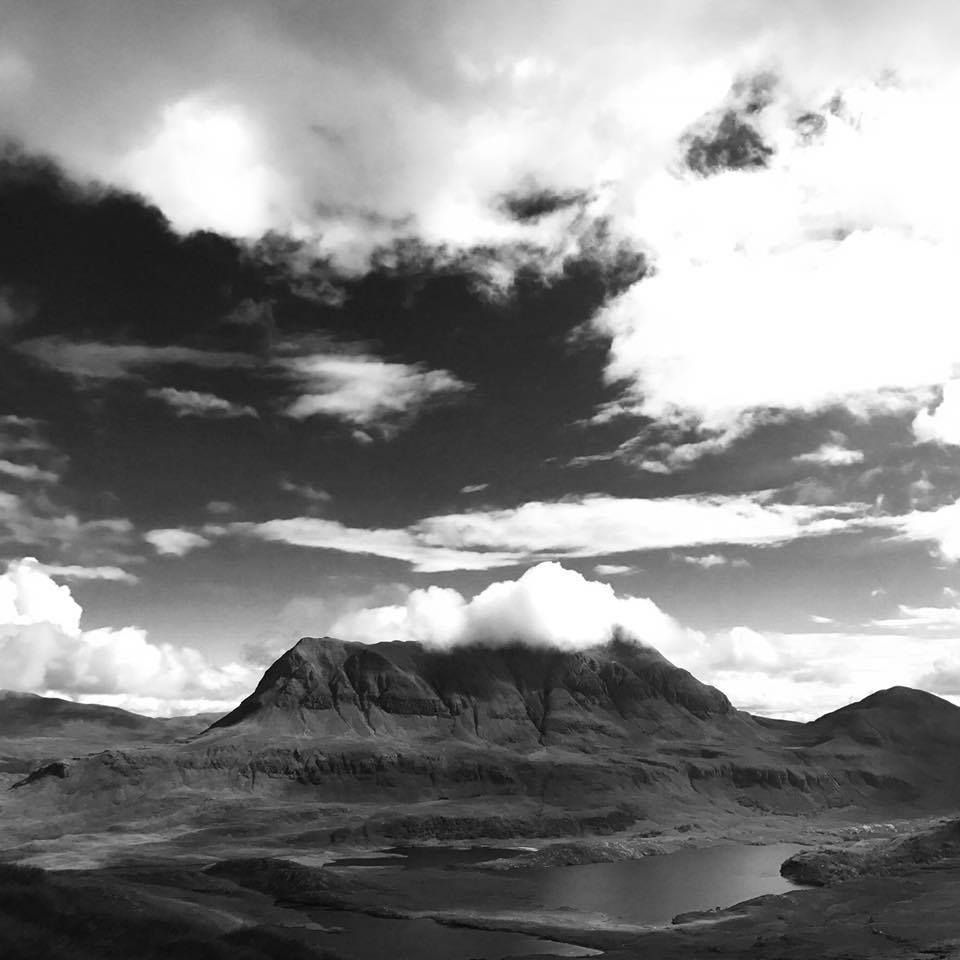
“The pen cannot describe the illustrious and overwhelming impression, which the opulent beauties of nature and locations delivered to the eye and the mind – an impression, that not only caught me in the flush of the moment, but also had a significant influence onto my whole future life, as I never, not in a foreign country or anywhere else in our country, had the opportunity to contemplate something so impressive and inspiring as what I have seen on this Finnmark journey.”

Caspar David Friedrich (1774–1840), is best known for his allegorical and mythical works on German landscapes which typically feature contemplative anonymous silhouettes that allow the audience project themselves inside the painting. Friedrich saw in nature an art form, a teaching even. He brought landscape paintings to a spiritual and philosophical level. By facing the nature in solitude, he believed that we could find answers to a world and society that took on the path of progress and materialism.
And the Wanderer Above the Sea of Fog, had a massive impact on me, as I saw the parallels between his era and our era. I had to be the wanderer and tried to put myself in his shoes with the eyes from the 21st century.
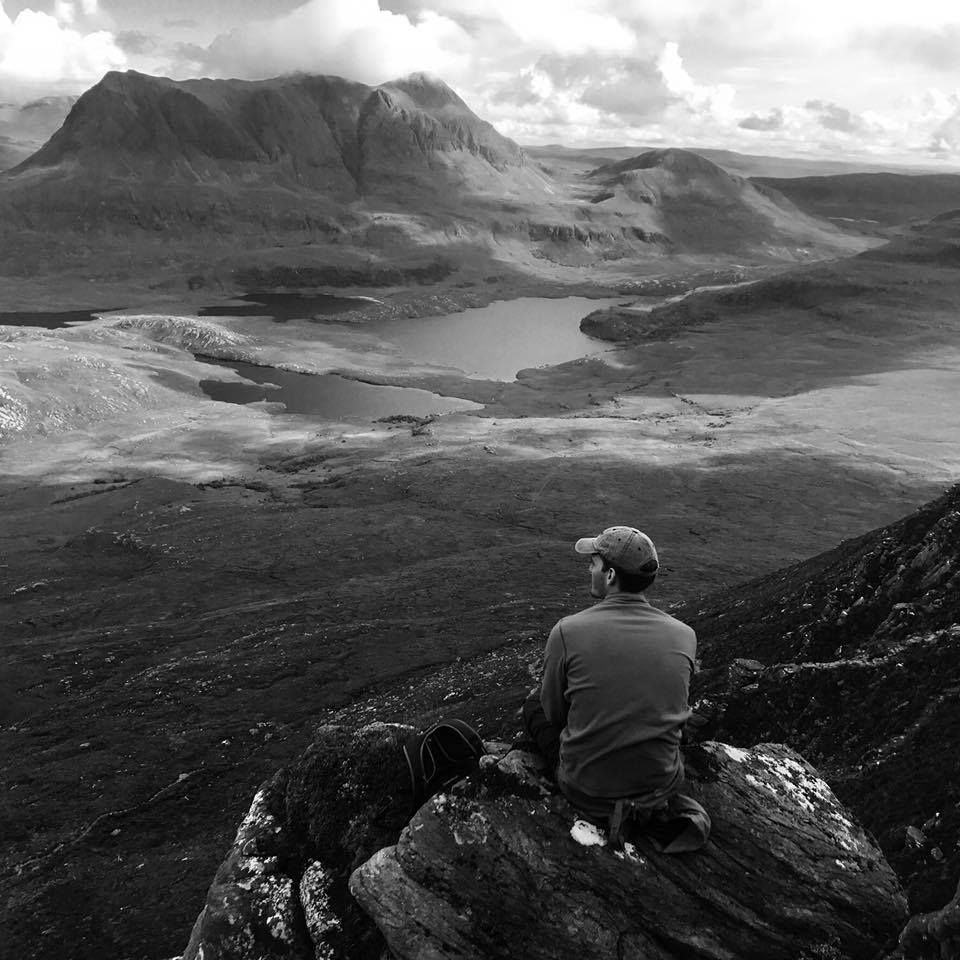
“Like a dream, the landscape plays with my memories and my very conception of reality. How to be sure that everything I live in the present is not a series of sets sadistically orchestrated by my subconscious, too anxious and begging for escape. The spilling of a divine white smoke on the hills covering my passage can only be a sign of the illusion of my experience.”
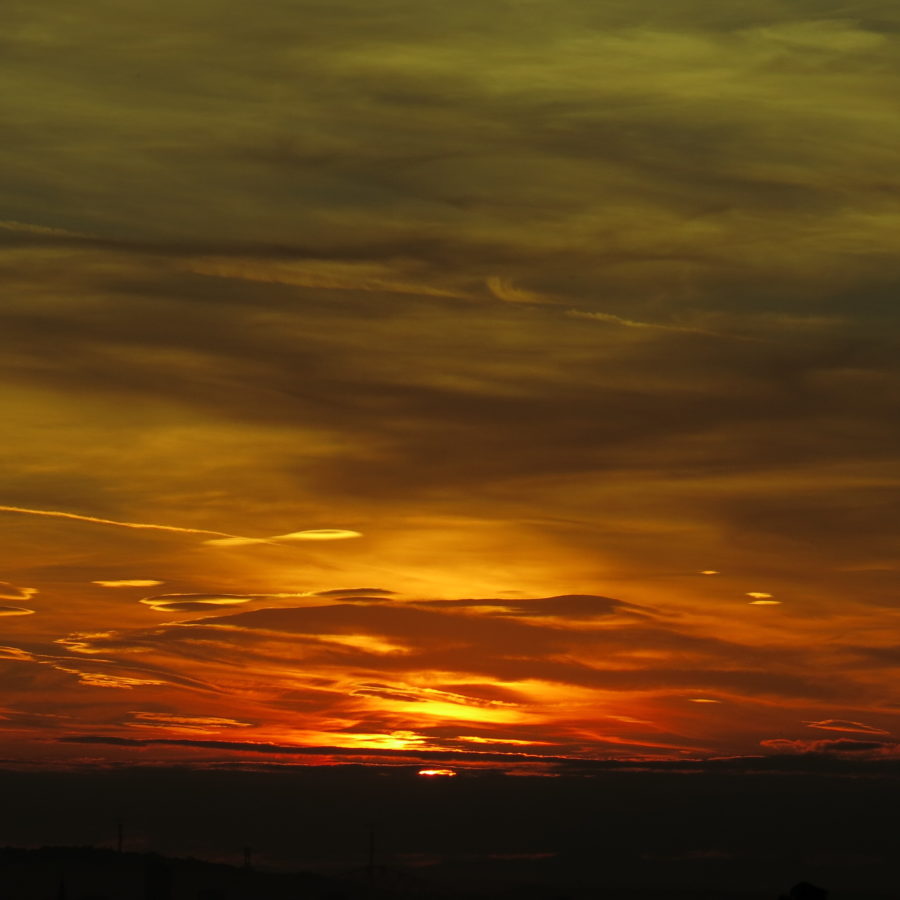
And there I was, after the two-months-long trip I finally reached the Norrdcap, 71° North, experiencing one of the most beautiful sunsets I had ever seen…
Was there any magic that occurred once there? Oh yes, it was magical, but nothing special that I hadn’t seen earlier on this trip… And let’s be honest, it disappointed me a little for a moment. Then, while I was sitting on the edge rock watching the North Sea offering me a stunning vision of a Norwegian sunset, I realized that this incredible day and my journey were coming to an end; I started to realize that changes and magic had happened, but it had nothing to do with a view or the number of miles I had done to get here. The change, or any sort of transformations, were solely within me…
“I return to the origins and transcribe from the heart to hand. Try to find the forgotten knowledge. Touch the innumerable and stay in communion with the indomitable. Well, I do not think I’m doing too badly. The quest for answers and the (I thought) inescapable expectations, these were found to be my obstacles. The emptiness, a so powerful contribution of matter. Do not ask anything the universe before being on the path of answers…”
DailyArt Magazine needs your support. Every contribution, however big or small, is very valuable for our future. Thanks to it, we will be able to sustain and grow the Magazine. Thank you for your help!